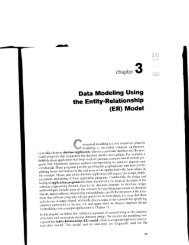13.1 through 13.5, 13.10 and 13.11
13.1 through 13.5, 13.10 and 13.11
13.1 through 13.5, 13.10 and 13.11
Create successful ePaper yourself
Turn your PDF publications into a flip-book with our unique Google optimized e-Paper software.
476 Chapter 13 Disk Storage, Basic File Structures, <strong>and</strong> Hashing13.4.2 Files, Fixed-Length Records, <strong>and</strong>Va riable- Length RecordsA file is sequence of records. In rnany cases, all records in a file are of the same^record type. If every record in the file has exactly the same size (in bytes), the file issaicl to be made up of fixed-length records. If different records in the file have differentsizes, the file is said to be rnade up of variable-length records. A file may havevariable-length records for severirl reasons:irr Jhs fiie records are of the same record type, but one or more of the fields areof varying size (variable-length fields). For example, the Name field ofEMPLOYEE can be a variable-length field.or The fiie records are of the sane record type, but one or more of the fieldsmay have multiple values for individual records; such a field is called arepeating field <strong>and</strong> a group oi values fbr the field is often called a repeatinggroup.rr The file records are of the sarne record type, but one or more of the fields areoptional; that is, they may have values for some but not all of the file records(optional fields).:', The file contains records of differe ttt recLtrd t,vpes <strong>and</strong> hence of varying size(mixed file). This would occur if related records of different types were c/usrered(placed together) on disk blocks; for exarnple, the GRADE_REPORTrecords of a particular student n.ray be placed following that STUDENT'srecord.The fixed-length EM PLOYEE records in Figtrre <strong>13.5</strong>(a) have a record size of 71 bytes.Every record has the same fields, <strong>and</strong> fleld iengths are fixed, so the system can identif,the starting byte position of each field relative to the starting position of therecord. This facilitates locating fleld values by programs that accessuch files. Noticethat it is possible to represent a file that logically should have variable-length recordsas a fixed-length records flle. For example, in the case of optional fields, we couldhave every field inclucled in every file rccorrl but store a special N U LL value if no valueexists for that fleld. For a repeating field, n'e could allocate as many spaces in eachrecord as the naxintunr nuntber of values that the fieid can take. In either case, spaceis lvasted when certain records do not have values for all the physical spaces providedin each record. Now rve cor.rsider other options for formatting records of a fileof variable-length records.For variable-Iength fields, each record has a value for eirch field, but we c-lo not knorvthe exact length of some field values. To determine the bytes within a particularrecord that represent each fleld, we can use special separator characters (such as ? or% or $)-which do not appear in ar.ry field value-to terminate variable-lengthfields, as showrr in Figure <strong>13.5</strong>(b), or we can store the length in bytes of the field inthe record, preceding the field value.A file of records with optional Jields can be formatted in different ways. If the totalnunrber of fields for the record type is large, but the nurnber of fields that actuallyappear in a typical record is small, lve can include in each record a sequence of














